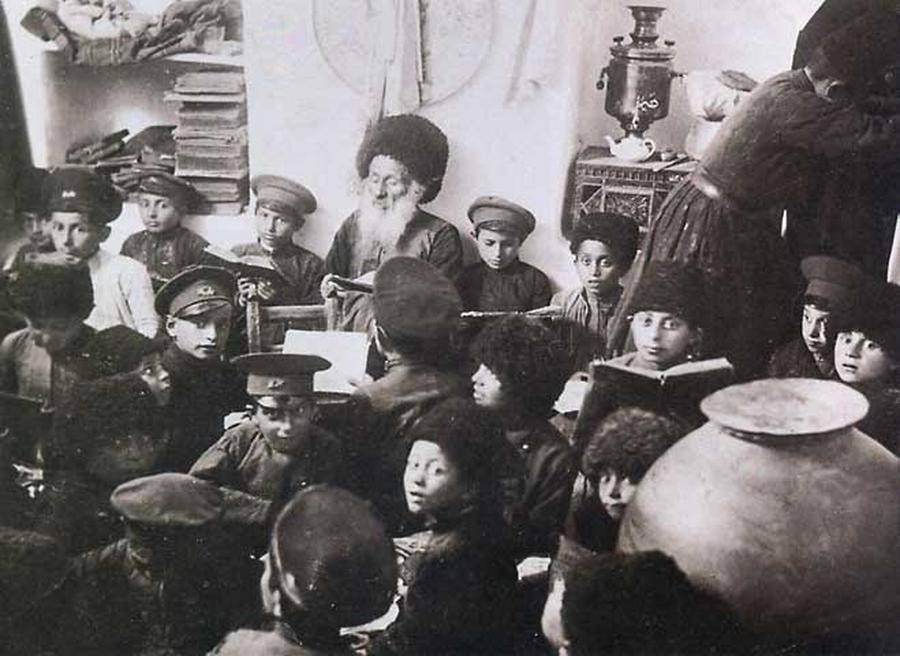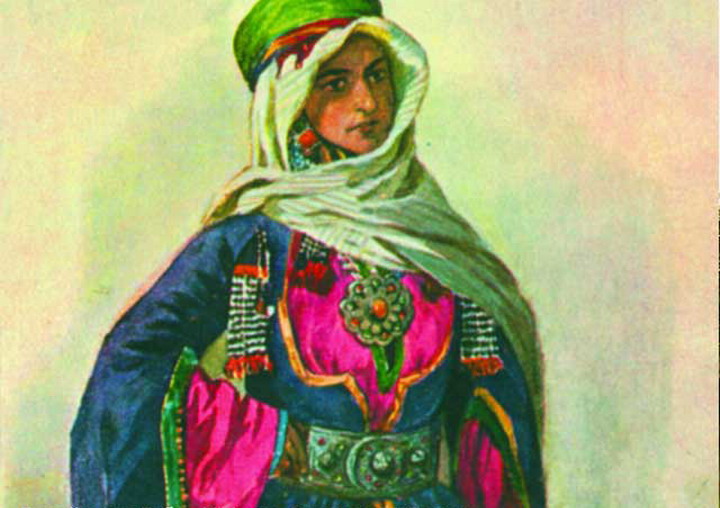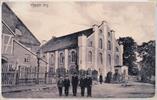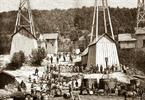Distribution
Historically Jews in Azerbaijan have been represented by various subgroups, mainly Mountain Jews, Ashkenazi Jews and Georgian Jews. Azerbaijan at one point was or still is home to smaller communities of Krymchaks, Kurdish Jews and Bukharian Jews, as well Gers (converts) and non-Jewish Judaistic groups like Subbotniks. In 2002, the total number of Jewish residents in Azerbaijan was 8,900 people with about 5,500 of them being Mountain Jews. A few more thousand descend from mixed families. As of 2010, the total Jewish population in Azerbaijan was 6,400. Jews mainly reside in the cities of Baku, Sumqayit, Quba, Oguz, Goychay and the town of Qyrmyzy Qasaba, the only town in the world where Mountain Jews constitute the majority. Historically, Jews used to live in and around the city of Shamakhi (mainly in the village of Mucu), but the community has been non-existent since the early 1920s.
History Azerbaijani Jewry traces its roots back to the existence of Caucasian Albania, an ancient and early medieval kingdom situated in what is now Azerbaijan, and populated with predecessors of modern Lezgins, Tsakhurs, Azeris, Udis, etc. Archaeological excavations carried out in 1990 resulted in the discovery of the remains of the 7th century Jewish settlement near Baku and of a synagogue 25 kilometres to the southeast of Guba.
Azerbaijani Jewry traces its roots back to the existence of Caucasian Albania, an ancient and early medieval kingdom situated in what is now Azerbaijan, and populated with predecessors of modern Lezgins, Tsakhurs, Azeris, Udis, etc. Archaeological excavations carried out in 1990 resulted in the discovery of the remains of the 7th century Jewish settlement near Baku and of a synagogue 25 kilometres to the southeast of Guba.
The first religious meeting-house in Baku was built in 1832 and was reorganized into a synagogue in 1896; more synagogues were built in Baku and its suburbs in the late 19th century. The first choir synagogue in Baku opened in 1910.
From the late 19th century Baku became one of the centres of the Zionist movement in the Russian Empire. The first Hovevei Zion was established here in 1891, followed by the first Zionist organization in 1899. The movement remained strong in the short-lived Democratic Republic of Azerbaijan (1918–1920) marked with the establishment of the Jewish Popular University in 1919, periodicals printed in Yiddish, Hebrew, Jud?o-Tat and Russian, and a number of schools, social clubs, benevolent societies and cultural organizations.
After Sovietization all Zionism-related activities including those of cultural nature that were carried out in Hebrew were banned. In the early 1920s a few hundred Mountain Jewish families from Azerbaijan and Dagestan left for Israel and settled in Tel-Aviv. The next aliyah did not take place until the 1970s, after the ban on Jewish immigration to Israel was lifted (see: Refusenik (Soviet Union)). Between 1972 and 1978 around 3,000 people left Azerbaijan for Israel. 1970 was the demographic peak for Azerbaijani Jews; according to the census, 41,288 Jews resided in Azerbaijan that year.
Many Jewish e'migre's from Azerbaijan settled in Tel-Aviv and Haifa. There are relatively large communities of Mountain Jewish expatriates from Azerbaijan in New York and Toronto.
A new Jewish synagogue, which became the biggest synagogue of Europe was opened in Baku on March 9, 2003. There is also a Jewish school, which has been operating in Azerbaijan since 2003. Currently, there are three synagogues in Baku, two in Quba and one in Oghuz.
Mountain Jews Different theories have been brought forward regarding the origin of Mountain Jews and the exact date of their settlement in the Caucasus. The commonly accepted theory views Mountain Jews as early medieval immigrants from Persia and possibly the Byzantine Empire forced out by Islamic conquests. They settled in Caucasian Albania, on the left bank of the Kura River and interacted with the Kypchak Kaganate of Khazaria, which lied to the north. It was through these early Jewish communities that the Khazars converted to Judaism making it their state religion.
Different theories have been brought forward regarding the origin of Mountain Jews and the exact date of their settlement in the Caucasus. The commonly accepted theory views Mountain Jews as early medieval immigrants from Persia and possibly the Byzantine Empire forced out by Islamic conquests. They settled in Caucasian Albania, on the left bank of the Kura River and interacted with the Kypchak Kaganate of Khazaria, which lied to the north. It was through these early Jewish communities that the Khazars converted to Judaism making it their state religion.
In the following centuries, Mountain Jews are believed to have moved further north making way to mass migration of Oguz Turks into the region. Their increase in number was supported by a constant flow of Jews from Iran. In the late Middle Ages Jews from Gilan founded a settlement in Oguz. Throughout the medieval epoch Mountain Jews were establishing cultural and economic ties with other Jewish communities of the Mediterranean. Agriculture and fabric trade was their main occupation until Sovietization. Some families practiced polygamy. In 1730, Huseyn Ali, the ruler of the Quba Khanate (then newly-separated from the Safavid Empire), issued a decree according to which Jews could own property in the khanate.
According to the 1926 Soviet census, there were 7,500 Mountain Jews in Azerbaijan (roughly 25% of the country's entire Jewish population). The exact numbers of the late Soviet period are unknown, since many were counted or preferred to be counted as Tats mostly due to the anti-Semitic attitude of the Soviet government. The theory of common origins of Tats and Mountain Jews (previously referred to as Judo-Tats) has been vehemently dismissed by a number of researchers.
Mountain Jews currently dominate the entire Jewish Diaspora of Azerbaijan. They speak a distinct dialect of the Tat language called Juhuri or Judae-Tat. The majority speaks more than one language, the second and/or third one most often being Azeri or Russian.
Ashkenazi Jews
1811 is the year when the first Ashkenazi Jews settled in Baku, but their mass immigration to what is now Azerbaijan did not start until the 1870s. Their immigration was relatively steady leading them to outnumber the local Mountain Jewish community by 1910. They settled mostly in the booming oil-rich city of Baku. The Caspian-Black Sea Company, one of the leading oil companies in the Russian Empire, was established in Baku by the wealthy Rothschild family of German Jewish origin. Ashkenazi Jews continued immigrating to Azerbaijan until the late 1940s, with a number of them being World War II evacuees from Russia, Ukraine and Belarus who chose to stay in their country of refuge.
Ashkenazi Jews were particularly active in Azerbaijani politics. Dr. Yevsey Gindes, a Kiev native, served as Minister of Health of the Democratic Republic of Azerbaijan (1918–1920). Along with that, 6 of the 26 Baku Commissars were Ashkenazi Jewish. As of 1912, around 1/3 of Baku's registered lawyers and physicians were Ashkenazi Jewish as well.
The post-1972 aliyah largely affected this subgroup of Azerbaijani Jews, as among all they were more exposed to emigration. This resulted in the decline of their number, making Mountain Jews the largest Jewish group of Azerbaijan by the mid-1990s.
Similar to many immigrant communities of the Czarist and Soviet eras in Azerbaijan, Ashkenazi Jews appear to be linguistically Russified. The majority of Ashkenazi Jews speak Russian as their first language with Azeri sometimes being spoken as the second. The number of Yiddish-speakers is unknown.
Other Jewish subgroups
It is not clear whether local Jewish communities had established ties with Georgian Jews before the Czarist epoch, however by the 1910s the Georgian Jewish diaspora in Baku already accounted for its own educational club. Today there are a few hundreds of Georgian Jews living in Azerbaijan.
In 1827 first groups of Judae-Aramaic-speaking Kurdish Jews started settling in Azerbaijan. In 1919–1939 a synagogue for Kurdish Jews functioned in Baku. After Sovietization the attitude of the Stalinist Soviet government towards them was somewhat unfavourable, and in 1951 all Kurdish Jews were deported from the Caucasus.
Krymchaks, who nowadays number only 2,500 people worldwide, consequently remained in quite low numbers in Azerbaijan throughout the 20th century. There were only 41 of them in the country, as of 1989. Bukharian Jews numbered 88 persons.
Gers and Subbotniks
Gers and Subbotniks were ethnic Russians from various parts of Russia who converted to Judaism primarily in the 1820s. In 1839–1841 the Czarist government expelled these communities to the newly-conquered South Caucasus, mainly to what is now Azerbaijan. Upon arriving here, they founded several settlements around Jalilabad (then called Astrakhan-Bazar), of which the largest one was Privolnoe. It later became the largest Judaistic Russian settlement in Russia. By the late Soviet epoch the overall number of Gers and Subbotniks in Azerbaijan was 5,000. There were only around 200 of them left in 1997 (when the region was visited by a research group from Saint Petersburg) with many planning to move to Russia and leaving virtually no chance for further preservation of this unique community.
Life of the community
In the Soviet era, Jews in Azerbaijan displayed high rates of marriage outside their community. In 1989, 48% of married Ashkenazi Jews and 18% of Mountain Jews were married to non-Jews.
Beginning in the 1960s, Azerbaijan's Jewish community experienced cultural revival. Jewish samizdat publications started being printed. Many cultural and Zionist organizations were reestablished in Baku and Sumqayit since 1987, and the first legal Hebrew courses in the Soviet Union were opened in Baku.
Education in Jewish languages was discontinued by the Kremlin in the 1930s and the 1940s, and teaching in Yiddish and Juhuri was replaced by that in Russian. After the fall of the Soviet Union, a yeshiva opened in Baku in 1994 and an Ohr Avner Chabad Day School was established in 1999. As of 1994, Hebrew was studied at one state university and offered as a course choice in two secondary schools. On May 31, 2007, a groundbreaking ceremony for the construction of the Ohr Avner Chabad Centre for Jewish Studies took place in Baku. The centre is intended to include a day school, a kindergarten, residence halls, a scientific centre, a library, etc.
As of 2007, there are three synagogues in Baku (one for each community, the Ashkenazi, Mountain and Georgian; the second one being the largest in the Caucasus), two in Qyrmyzy Qasaba near Quba, and one in Oguz. The Ger synagogue in Privolnoe is probably no longer functioning due to active emigration within the Ger community in the 1990s.
In 2005, Yevda Abramov, himself a Jew, was elected to the National Assembly of Azerbaijan as an MP representing the Rural Guba riding.
|
Important information on visa: If you're going to vizit Azerbaijan check the latest information of visa regime here >>>. Regularly updated data, helpful advice and expert guidance. If you have any questions, please do not hesitate to contact us. |









